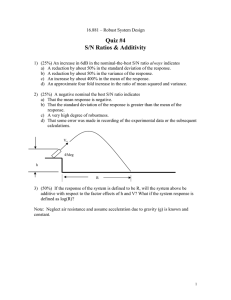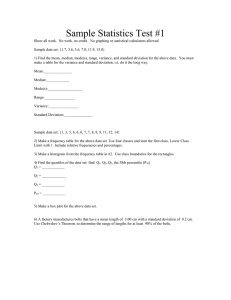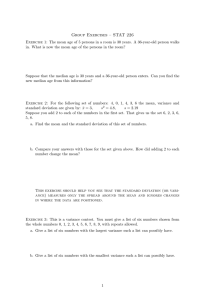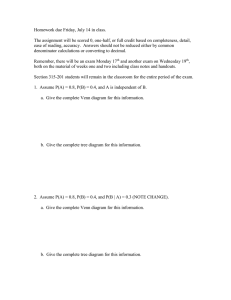Solution to Quiz #4 S/N Ratios & Additivity
advertisement
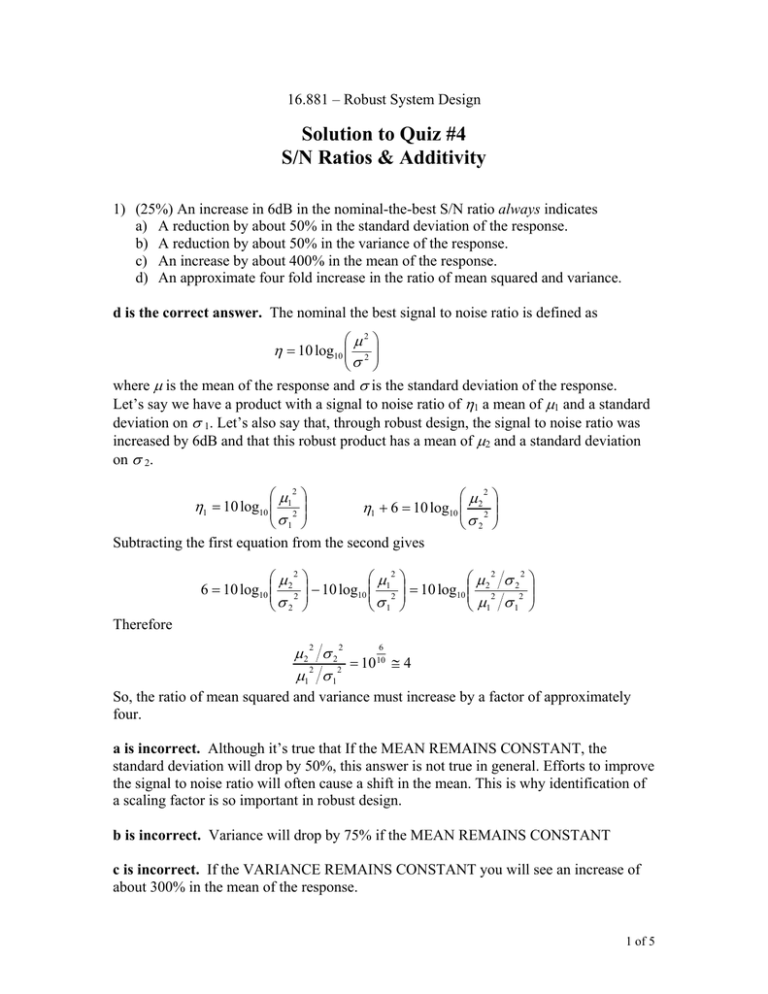
16.881 – Robust System Design Solution to Quiz #4 S/N Ratios & Additivity 1) (25%) An increase in 6dB in the nominal-the-best S/N ratio always indicates a) A reduction by about 50% in the standard deviation of the response. b) A reduction by about 50% in the variance of the response. c) An increase by about 400% in the mean of the response. d) An approximate four fold increase in the ratio of mean squared and variance. d is the correct answer. The nominal the best signal to noise ratio is defined as µ2 2 σ where µ is the mean of the response and σ is the standard deviation of the response. Let’s say we have a product with a signal to noise ratio of η1 a mean of µ1 and a standard deviation on σ 1. Let’s also say that, through robust design, the signal to noise ratio was increased by 6dB and that this robust product has a mean of µ2 and a standard deviation on σ 2. η = 10 log10 µ12 µ2 2 η1 + 6 = 10 log10 2 2 σ 1 σ2 Subtracting the first equation from the second gives η1 = 10 log10 µ 2 µ 2 µ 2 σ 2 6 = 10 log10 2 2 − 10 log10 1 2 = 10 log10 2 2 22 σ2 σ1 µ1 σ 1 Therefore 6 µ22 σ 22 10 = 10 ≅ 4 µ12 σ 12 So, the ratio of mean squared and variance must increase by a factor of approximately four. a is incorrect. Although it’s true that If the MEAN REMAINS CONSTANT, the standard deviation will drop by 50%, this answer is not true in general. Efforts to improve the signal to noise ratio will often cause a shift in the mean. This is why identification of a scaling factor is so important in robust design. b is incorrect. Variance will drop by 75% if the MEAN REMAINS CONSTANT c is incorrect. If the VARIANCE REMAINS CONSTANT you will see an increase of about 300% in the mean of the response. 1 of 5 2) (25%) A negative nominal the best S/N ratio indicates a) That the mean response is negative. b) That the standard deviation of the response is greater than the mean of the response. c) A very high degree of robustness. d) That some error was made in recording of the experimental data or the subsequent calculations. b is the most correct answer. Strictly speaking, the answer should have been “That the standard deviation of the response is greater than the absolute value of mean of the response. The nominal the best signal to noise ratio is defined as µ2 η = 10 log10 2 σ where µ is the mean of the response and σ is the standard deviation of the response. Remember what a log function looks like? Plotting the signal to noise ratio versus mean squared over variance, we see that it crosses the x axis at 1. 10 5 η 0 5 10 0 1 2 3 4 5 µ σ2 2 Another way to think of it is this. Rearranging the definition of the S/N ratio we find that η /10 10 µ2 = 2 σ So, if η is zero, the ratio of mean squared to variance is 1. If η is positive, the ratio of mean squared to variance is greater than1. If η is negative, the ratio of mean squared to variance is less than 1. 2 of 5 Vo 45deg h R 3) (50%) If the response of the system is defined to be R, will the system above be additive with respect to the factor effects of h and V? What if the system response is defined as log(R)? Note: Neglect air resistance and assume acceleration due to gravity (g) is known and constant. Proposed solution The primary purpose of this problem is to see how you THINK about design for additivity. The secondary purpose is to get you warmed up for the catapult experiment. Remember, you have to consider the physics of a process to do robust design properly. First of all, when you think about design for additivity, you need to think about how a change in each control factor individually affects the response. Then you have to think about how both control factors affect the response when changed in concert. A few sketches on the next page illustrate one approach to the problem. 3 of 5 First, consider the baseline case. The flight of the golf ball can be viewed as having two parts. 1) The part due to V alone which is the parabola above the initial height 2) The part due to h which is the nearly triangular bit at the end. Due to the 45 degree angle of the projectile, this second part of the flight should add an increment (h) to the range from the first part of the flight. Now, what happens when you cut V in half? The range in the first portion is cut in half, but the second part of the flight is nearly unaffected since the 45 degree angles in the triangle are preserved. As long as h is not too large compared to V^2/g, this approximation should suffice. What happens when you cut h in half? The range in the first portion is unaffected, but the second part of the flight is cut approximately in half. As long as h is not too large compared to V^2/g, this approximation should suffice. What happens when you cut both h and V in half? The shape of the entire flight should be scaled down by a factor of two. Cut V in Half Baseline 0.5Vo Vo 45deg 45deg h h h Ro h 0.5Ro h R Cut h in Half Cut Both h and V in Half Vo 0.5h 0.5Vo 45deg 0.5h h 0.5Ro Ro 0.5h 0.5h 4 of 5 Now you should be able to see that the model is very nearly additive. If you need to be convinced further, a good way to organize this thinking is with an interaction plot. R h Ro+h Ro+0.5h 0.5h 0.5Ro+h 0.5Ro+0.5h 0.5Vo Vo V Finally, it should be clear that of the response of range R to h and V are nicely additive, then applying a log transform will degrade that additivity (perhaps only slightly). 5 of 5
